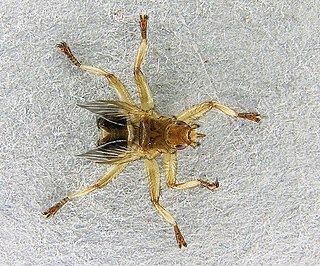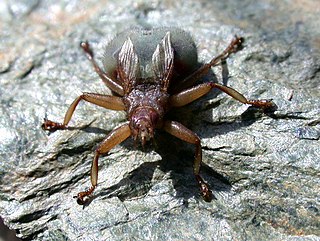
Flies are insects of the order Diptera, the name being derived from the Greek δι- di- "two", and πτερόν pteron "wing". Insects of this order use only a single pair of wings to fly, the hindwings having evolved into advanced mechanosensory organs known as halteres, which act as high-speed sensors of rotational movement and allow dipterans to perform advanced aerobatics. Diptera is a large order containing an estimated 1,000,000 species including horse-flies, crane flies, hoverflies, mosquitoes and others, although only about 125,000 species have been described.

Calyptratae is a subsection of Schizophora in the insect order Diptera, commonly referred to as the calyptrate muscoids. It consists of those flies which possess a calypter that covers the halteres, among which are some of the most familiar of all flies, such as the house fly.

Hippoboscoidea is a superfamily of the Calyptratae. The flies in this superfamily are blood-feeding obligate parasites of their hosts. Four families are often placed here:

Hippoboscidae, the louse flies or keds, are obligate parasites of mammals and birds. In this family, the winged species can fly at least reasonably well, though others with vestigial or no wings are flightless and highly apomorphic. As usual in their superfamily Hippoboscoidea, most of the larval development takes place within the mother's body, and pupation occurs almost immediately.

The Streblidae are a family of flies in the superfamily Hippoboscoidea, and together with their relatives the Nycteribiidae, are known as bat flies. They are winged or wingless ectoparasites of bats, and often have long legs. They appear to be host-specific, with different species of bat flies occurring only on particular species of bat hosts, sometimes with multiple species of flies sharing a host bat.

Nycteribiidae is a family of the true fly superfamily Hippoboscoidea are known as "bat flies", together with their close relatives the Streblidae. As the latter do not seem to be a monophyletic group, it is conceivable that bat flies cannot be united into a single family.
Dormer's bat or Dormer's pipistrelle is a species of vesper bat. It is the only species in its genus. It is found in Bangladesh, Bhutan, India, and Pakistan. Its natural habitats are subtropical and tropical dry forests, arable land, plantations, rural gardens, and urban areas.

Crataerina pallida, the swift lousefly, is a species of biting fly in the family of louse flies Hippoboscidae. These flies are commonly encountered in the nests of the common swift in Europe and Asia.

Crataerina is a genus of louse flies in the family Hippoboscidae. All are parasites of birds, feeding on the blood of various species of Apodidae (swifts) and Hirundinidae. The genus is sometimes spelled Craterina.
Hippoboscinae is a subfamily of the fly family Hippoboscidae. All are parasitic, and unlike some other members of the Hippoboscidae, all Hippoboscinae are winged species.

Lipopteninae is a subfamily of the fly family Hippoboscidae. All are parasitic.

Hippobosca is a genus of flies in the family Hippoboscidae. There are seven known species. There are numerous synonyms.

Ornithomyinae is a subfamily of the fly family Hippoboscidae. All are blood feeding parasites, for the most part on birds, though some have mammals as hosts.
Bat flies are members of the insect order Diptera, the true flies, which are external parasites of bats. Two families of flies are exclusively bat flies: Nycteribiidae and Streblidae. Bat flies have a cosmopolitan distribution, meaning that they are found around the world. Nycteribiidae and Streblidae are members of the superfamily Hippoboscoidea, along with the families Hippoboscidae and Glossinidae.

Rhamphomyia sulcata is a species of dance flies, in the fly family Empididae. It is included in the subgenus Rhamphomyia. It is found in most of Europe, except the Balkan Peninsula.

Rhamphomyia pilifer is a species of dance flies, in the fly family Empididae. It is found in most of Europe, except the Balkan Peninsula and the Iberian Peninsula.

Crataerina hirundinis is a species of flies belonging to the family Hippoboscidae. It was formerly placed in its own genus, Stenepteryx.

Ornithomya fringillina is a species of fly in the family Hippoboscidae. It is found in the Palearctic.

Ornithomya avicularia is a species of fly in the family Hippoboscidae. It is found in the Palearctic. The species prefers tree-dwelling birds as hosts.
Basilia fletcheri is parasitic bat fly in the genus Basilia, in the subgenus Basilia. It is found in India.














